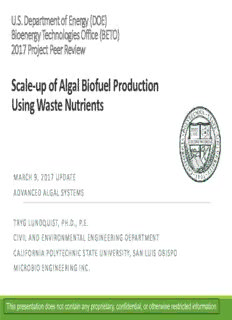
Scale-up of Algal Biofuel Production Using Waste Nutrients PDF
Preview Scale-up of Algal Biofuel Production Using Waste Nutrients
U.S. Department of Energy (DOE) Bioenergy Technologies Office (BETO) 2017 Project Peer Review Scale-up of Algal Biofuel Production Using Waste Nutrients MARCH 9, 2017 UPDATE ADVANCED ALGAL SYSTEMS TRYG LUNDQUIST, PH.D., P.E. CIVIL AND ENVIRONMENTAL ENGINEERING DEPARTMENT CALIFORNIA POLYTECHNIC STATE UNIVERSITY, SAN LUIS OBISPO MICROBIO ENGINEERING INC. This presentation does not contain any proprietary, confidential, or otherwise restricted information Goal Statement: Prepare for Scale-Up • Prepare for scale-up of 2500 gal/ac-yr of biofuel intermediates (BFI) via hydrothermal liquefaction (HTL) of microalgae grown at 7 acres of existing raceways at a wastewater treatment facility. • Maximize productivity with CO addition and demonstrate 2 bioflocculation/settling harvesting of the algal biomass at pilot scale. ▪ Techno economic analysis (TEA) and lifecycle assessment (LCA). Measured Project Outcomes • 33 g biomass / m2-day annual average x 0.35 g HTL oil / g algae 4,100 gal/ac-yr ignoring losses • $4 - $9 per gal BFI depending on revenue streams & RINs Relevance • Lower cost by: increasing productivity, using low-cost harvesting, increasing HTL yield/quality, and capturing wastewater revenue and RINs. • Basic algae wastewater treatment is already full-scale and available for demonstration of HTL at pilot scale. 2 Quad Chart Overview MYPP Barriers: Aft A-D, G, H & J Mixotrophic data supports projection of Timeline 4,100 gal/ac-yr of biofuel intermediate. Project start: September 30, 2013 Climate-simulation lab reactors developed Project end: June 30, 2016 (extended to for autotrophic strain evaluation (LEAPS). June 30, 2017) Over a year of pilot cultivation using polycultures, integrated with low-cost, low- Percent complete: 89% input harvesting and thickening. Budget Multiple HTL runs with characterized feedstock and recycling of HTL nutrients. Total Planned Partners Total Funding • Total project $2,049,157 Costs FY (FY 17- 12 – FY 16 Project End • SNL (7% of total project incl. cost share all FY 14 FY 15 Costs Costs Date) FYs): Look for relationships between dominant organisms and culture DOE 13,329 361,686 428,873 127,000 performance Funded • PNNL (27%), hydrothermal liquefaction of Project MicroBio MicroBio MicroBio MicroBio algal biomass, modeling strain growth Cost optimization Share 48,583 149,664 0.00 0.00 Comp.* ______ _______ _______ _______ • MicroBio Engineering Inc. (10% as cost Cal Poly Cal Poly Cal Poly Cal Poly share): LCA/ TEA and engineering services • Delhi County Water District, support in use 0.00 11,269 115,844 93,004 of the project site 3 1 - Project Overview Scale-up Process Flow (RNEW®): • Wastewater algae biocrude + water for reuse • Reuse can be crop irrigation or further algae production . with eventual blowdown Optional Disinfection Pilot systems were operated at a full-scale raceway wastewater treatment plant to learn to maximize productivity for scale-up in Phase-2. Delhi, California (pop. 11,000, San Joaquin Valley) operates a 0.6 million gallon per day (MGD) wastewater treatment plant that includes two 3.5-acre algal raceways for oxygen production and nutrient removal. The PI was a design engineer on the original construction in 1998. 5 At full-scale, Delhi algae are coagulated, settled, and solar dried. ~100,000 gallons of 3% solids algae in decanted settling basin Solar dried algae Concrete drying pad Nine 3.5-m2 raceways with automated controls, settling units, thickener, and drying beds were installed to study optimization of productivity and harvesting. Manipulated Variables Residence time Influent water source CO addition 2 Primary Clarifier Pilot-Scale Raceways Algae Settlers (2-hour residence time) (2-5 day HRT) (2-3 hours) Raw WW Supernatant Algae Treated Effluent Algae Algae Algae Drying Screens or Beds Algae Thickener Supernatant Tank 8 Pacific Northwest & Sandia National Labs supported the pilot with a new PBR, genetic characterization, and conversion to intermediate. Cal Poly closed loop on HTL wastewater. MicroBio provided equipment, hydraulic studies, TEA, LCA, and consulting. Community genetics Pond simulators to understand Wastewater HTL aqueous waste developed & bioflocculation & polyculture HTL and recycled for algae validated (PNNL-Sq) productivity (SNL) hydrotreat (PNNL-R) growth (Cal Poly) 2 – Approach (Management) PI Tryg Lundquist and his Cal Poly team carry out algal cultivation studies at Delhi. Dr. Lundquist is responsible for the coordination of all project partners and leading partner meetings. TASK 1: Develop models to identify high-performance strains and culture methods (Lead: Dr. Michael Huesemann PNNL) TASK 2: Maximize algal productivity and harvesting efficiency in Delhi pilot ponds (Lead: Cal Poly, Dr. Todd Lane Sandia) TASK 3: Full-scale raceway hydraulic characterization (Lead: Cal Poly and MicroBio Engineering, Stan Feathers, General Manager, Delhi County Water District) TASK 4. Biomass processing to biofuel intermediates (Lead: Dr. Dan Anderson PNNL, and Cal Poly) TASK 5. Scale-up engineering analysis, modeling, and planning (Lead: Dr. John Benemann MicroBio Engineering and Cal Poly) TASK 6. Stage Gate Review and Preparations (Lead: Cal Poly, with PNNL, SNL, and MicroBio Engineering) 10
Description: